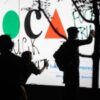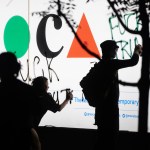
Courtesy photo
For years, Simon Miccio dreamt about a space in Aspen to open an art gallery. When one opened right in front of the Aspen Art Museum, he decided to take the town up on its offer.
Now, with his namesake gallery and an inaugural show highlighting a national non-profit in a global art hub directly across from an internationally-renowned art museum, he steps to the plate for his most ambitious project as he aims to forge family through community conversations.
Aspen’s community has kept him returning throughout the last 11 years: “As an art capital of the world and a home base, I have always felt secure in creating family here,” he said. “I have met people in this town who I consider family, and I have the privilege to get to know and develop relationships with a variety of amazing people that will be with me forever.”
He moved to Aspen from Argentina in December 2012 with the plan to ski and work in local restaurants. He soon began supporting the marketing campaigns of the once-popular Cha Cha Gallery, bringing his economic background to bear. Seeing the gallery as a learning opportunity, it sparked his interest as he began proposing ideas to the gallery. He became the gallery’s director, began his advisory practice, and expanded his art dealing.
Realizing that having his own gallery would be his next step in serving as a bridge and voice to artists, he started Miccio Gallery in May of this year.
“As we go through this together, it’s still a lot of work, and I’m grateful,” he said. “It’s incredible to see the amazement of people coming into the gallery.”
And while his recent debut in Aspen may seem like a celebration, it’d be easy to let the moment skip past the trying years when this did not seem likely for the gallery owner.
“It’s been a journey,” he added.
As a next step, commissioning Jesse Krimes — founder and director of The Center for Art and Advocacy — has proved compelling. In Simon Miccio Gallery’s inaugural exhibition, “Center for Art and Advocacy,” he and Miccio showcase the work of nine, justice-impacted artists who have traversed societal circumstances to go beyond judicial labels.
The show opened July 28 and runs through the end of this week, closing Friday, Aug. 18, at 620 E. Hyman Ave.
The Center for Art and Advocacy is a non-profit organization that funds and supports justice-impacted artists nationally to shift the narrative around the label of formerly incarcerated. For his part, when Krimes considered the perfect location to promote his advocacy and practice, he thought — where else? — Aspen.
“We need to simultaneously change the cultural narratives of who we view as valuable and disposable while also working on policy changes across the country,” he said. “What better way to showcase the work that we do and will support in the future than by showing it. This was an incredible opportunity to have partners who believe in the mission, understand our work, and provide us a platform to support our artists.”
Through meeting the artists and viewing their work, a communal bond forms and the narrative that decenters these creatives by focusing on their past deeds shifts toward conversations that humanize those impacted and centers the criticality of their accounts in mass incarceration.
Krimes aims to bring people into the systematic structures that govern mass incarceration, a world which may feel uncomfortable for some people but produces new perspectives.
“My work is about challenging value systems and utilizing traditional aesthetic tropes of beauty to draw people into brutal, dehumanizing concepts that people don’t want to think about in a way to get people to engage in the issue,” he said.
Since his solo exhibition in Aspen in 2020, he has been engaged as a local creative presence with the Aspen Art Museum and local galleries, having shown in the town’s galleries and donated works to ArtCrush. His own practice has engaged Aspenites while he continues taking his advocacy work to the next level. The Center’s Fellowship program has funded 31 Fellows over the past six years across the disciplines of visual arts, poetry, creative writing, filmmaking, dance, performance, and more.
“Artwork tells a very human story, whereas statistics and numbers don’t allow for the human elements to be shown,” he said. “People see the artwork and get to meet the artists, hear from them, and see the individual in front of them. That’s the power of art.”
Showing his fellows’ work in Aspen has been an amazing experience in a supportive community.
“This helps our artists become more vulnerable,” he said. “The openness and generosity of this community, in combination with how our artists often exit incarceration, is the perfect scenario that allows people to re-connect back into society and feel safe and supported as they build their career,” Krimes said.
The center’s new gallery space in Brooklyn will debut this year.
“Most of our attention is in setting the gallery space up and organizing and curating a show there for later this fall,” he said.
Though the fellowship has seen success during the past six years, top of mind for him is the future.
“We’re branching out — the academy will start next year and will fund and support emerging artists with mentorship and criticality with their work, which will create a pathway into the fellowship,” he said, “which will be scaled across the country by partnering with other museums and institutions that can work in proximity to their communities that are directly impacted.”
A residency program is also slated for next year.
“The residents will have time and space to explore new work and materials, cultivate community with mentors and advocates, and connect and network with visiting artists,” he added.
Mental-health issues persist after people return home from prison. He hopes to offer wraparound services for his directly-impacted artists who may experience a steeper learning curve than their counterparts.
“That’s the core of what we try to do at the center: build systems and structures that allow people to thrive,” he said.
Finding work with a criminal background can prove challenging, and so the center will serve as a site for people to translate their skills gained from a life in prison to opportunities once rejoined with society.
“We’ll hire formerly-incarcerated chefs and people who are coming out of the horticulturist programs in prison to work the land, grow the food, and feed our residents,” he said.
Krimes is clear in his vision that this start marks the makings of something larger. There’s a shared and genuine bond between him and Miccio. For both advocates, the journey hasn’t been without pains, yet they look forward to the future.
“What amazes me the most is that this is just the beginning,” Krimes said. “I’m excited for what is to come. We are just warming up.”
This post was originally published on this site be sure to check out more of their content.







